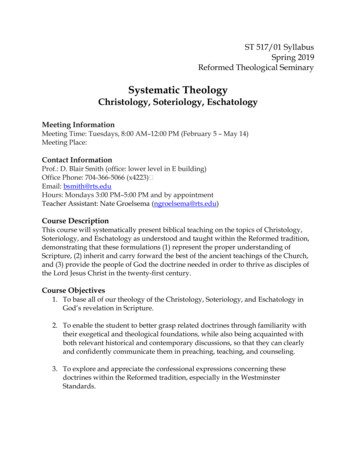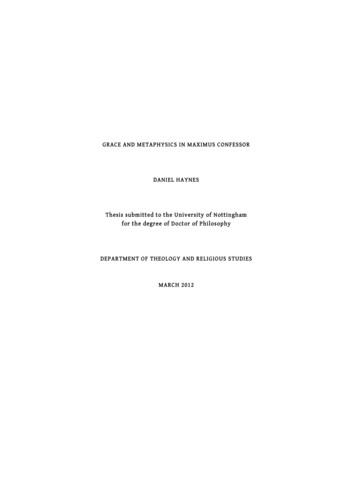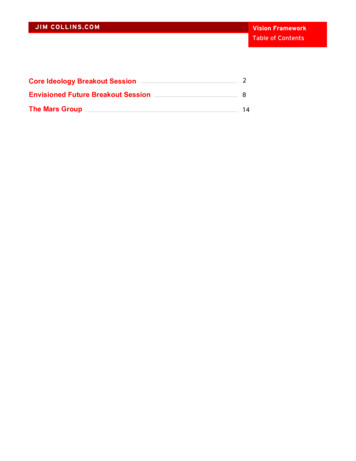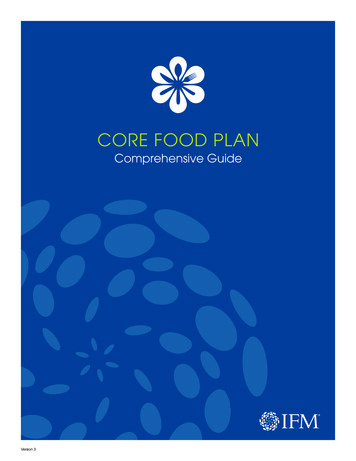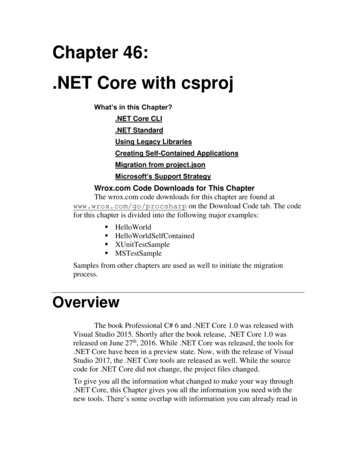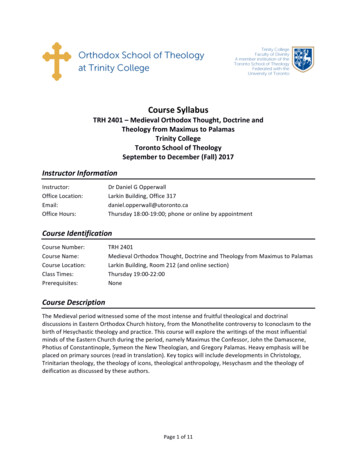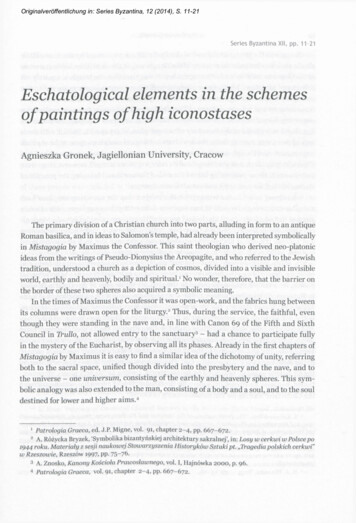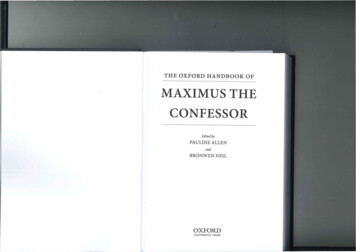
Transcription
THE OXFORD HANDBOOK OF.MAXIMUSTHECONFESSOR.Edited byPAULINE ALLENandBRONWEN NEILOXFORDUNIVERSITY PRESS
CoNTENTSList ofIllustrationsList ofAbbreviationsList of ContributorsxviixixxxviiPART I HISTORICAL SETTING1.Life and Times ofMaximus the Confessor3PAULINE ALLEN2.A New Date-List of the Works ofMaximus the Confessor19MAREK JANKOWIAK AND PHIL BOOTH3. Byzantium in the Seventh CenturyWALTER E. KAEGI4. Maximus, a Cautious Neo-Chalcedonian106CYRIL HovoRUNPART 11 THEOLOGICAL ANDPHILOSOPHICAL INFLUENCES5. Classical Philosophical Influences: Aristotle and Platonism127MARIUS PORTARU6. The Foundation of Origenist Metaphysics149PASCAL MUELLER-JOURDAN7. The Ascetic TraditionMARCUS PLESTED8. Pseudo-Dionysius the Areopagite and Maxim us the ConfessorY SABEL DE ANDIA177
xivCONTENTS9· Mindset (yvwfl'l) in John ChrysostomCONTENTSXVPARTIV RECEPTION194RAYMOND J, LAIRD22.10. Augustine on the Will212The Georgian Tradition on Maximus the Confessor439LELA KHOPERIAJoHANNES B6RJESSON23. Maximus' Heritage in Russia and Ukrainen. Divine Providence and the Gnomic Will before Maxim us235GRIGORY BENEVICHBRONWEN NEIL24. The Impact ofMaximus the Confessor on John Scottus EriugenaCATHERINE KAVANAGHPART Ill WORKS AND THOUGHT12.Exegesis of Scripture253PAUL M. BLOWERS25. Maximus the Confessor's Influence and Reception in Byzantineand Modern Orthodoxy500ANDREW LOUTH13. Maxim us the Confessor's Use of Literary Genres274PETER VAN DEUN26. The Theology of the Will516IAN A. McFARLAND14. Passions, Ascesis, and the Virtues27. Maximus and Modern PsychologyDEMETRIOS BATHRELLOS533MICHAEL BAKKER15. Christocentric Cosmology28. Maximus the Confessor and EcumenismTORSTEIN T. TOLLEFSENA. EDWARD SIECIENSKII.16. Eschatology in Maxim us the Confessor548322ANDREAS ANDREOPOULOS29. Reception ofMaximian Thought in the Modern EraJOSHUA LOLLAR17. The Mode of Deification341General IndexIndex ofAncient PersonsIndex ofModern PersonsIndex ofBib.lical Citations}EAN-CLAUDE LARCHET18. Spiritual Anthropology in Ambiguum 7ADAM G. COOPER19. Mapping Reality within the Experience ofHolinessDoRu CosTACHE20.Christian Life and Praxis: The Centuries on LoveGEORGE C. BERTHOLD39721.Liturgy as Cosmic Transformation414THOMAS CATTOI581595599609
532IAN A. MCFARLANDBlowers, P. M. (2012), 'Maxim us the Confessor and John of Damascus on Gnomic Will (yVWf.!TJ)in Christ: Clarity and Ambiguity; Union Seminary Quarterly Review 63: 44-50.Borjesson, J. (2015), 'Augustine on the Will', in P. Alien and B. Neil (eds.), The Oxford HandbookofMaximus the Confessor (Oxford: Oxford University Press), 212-34.Dihle, A. (1982), The Theory ofWill in Classical Antiquity (Berkeley: University of California Press).Doucet, M. (1985), 'La Volonte humaine du Christ, specialement en son agonie: Maxime leConfesseur, interprete de l'Ecriture: Science et Esprit 27: 123-59.Gavin, J., SJ (2009), 'They Are Like the Angels in the Heavens': Angelology and Anthropology in theThought ofMaximus the Confessor (Rome: Institutum Patristicum Augustinianum).Grillmeier, A. with Hainthaler, T. (1995), Christ in Christian Tradition, 2. From the Council ofChalcedon (451) to Gregory the Great (590-604), part 2. The Church of Constantinople in theSixth Century, trans. J. Cawte and P. Alien (London-Louisville, KY: Mowbray).Hovorun, C. (2008), Will, Action and Freedom: Christological Controversies in the Seventh Century(Leiden: Brill).Lethel, F.-M. (1982), 'La Priere de Jesus a Gethsemani clans la controverse monothelite: inHeinzer-SchOnborn, 207-14.Madden, J. D. (1982), 'The Authenticity of Early Definitions of the Will (thelt sis): in HeinzerSchonborn, 61-79.Mu eller-Jourdan, P. (2015), 'The Foundation ofOrigenist Metaphysics: in P. All en and B. Neil (eds.),The Oxford Handbook ofMaxim us the Confessor (Oxford: Oxford University Press), 149-63.Portaru, M. (2015), 'Classical Philosophical Influences: Aristotle and Platonism: in P. Alien andB. Neil (eds.), The Oxford Handbook of Maximus the Confessor (Oxford: Oxford UniversityPress), 127-48.Sherwood, P. (1955b), The Earlier Ambigua ofSt Maximus the Confessor (Rome: Herder).Thunberg, L. (1995), Microcosm and Mediator: The Theological Anthropology of Maximus theConfessor, 2nd edn. (Chicago: Open ············MAXIMUS AND ············MICHAEL BAKKERPsYCHOLOGY as a science started to develop in the West when Maximus was still relatively unknown. There are some analogies that are worth exploring, even though the eis no evidence of any significant influence of his thinking on modern psychology. In th1schapter the following two parallels will be treated: (1) that between Maximus' asceticteachings and cognitive therapy and (2) that between his view of the soul and depthpsychology.By way of introduction, let us turn to Maxim us' letter to George the prefect of theprovince of Africa, the first of his epistles according to the numbering of the PG. Aftercomparing his friend to nothing less than the sun, Maximus remarks that virtue is a matter of intention (yvWflf]) rather than rank, and imitation of God a matter of disposition(ota8eat ;) rather than dignity (Bp. 1, PG 91. 364A). He also contrasts the blessed oneslike prefect George, in whom the firm love for God has taken root in the depth of theirsouls, with those who prefer material things, whose disposition (Ota8eat ;) is not fixedbut is subject to change (PG 91. 364B-365A). He then writes the following: 'Nothing ofwhat exists, my blessed master, can divert you from the good and deifying habit (e t ;)that accompanies your intention (yVWflfJ) on your way towards God' (PG 91. 365B). Weencounter here three keywords in Maximus' vocabulary-ota8eat ;, 1 ;, and YVWflTJwhich often occur together in his oeuvre. The first of them, 8ta8ecnc;, can be translatedin a straightforward manner as 'disposition. The second, 1 ;, is a noun derived fromthe Greek word 'to have' (like its Latin counterpart habitus), indicating an acquiredstate or pattern of behaviour. The third term, yv .Of!fJ, has even more shades of meaning(opinion, choice, disposition of willing) in addition to the translation 'intention'; in fact,this is the word that Maximus used to differentiate the deliberative 'gnomic will' fromthe stable 'natural will' (as part of his intellectual battle with the monothelite heresy).In cognitive-behavioural therapy (CBT), one encounters a similar stress on habits orbehavioural patterns with which are connected opinions and automatic thoughts.
534MICHAEL BAKKERIn his letter Maximus also mentions the 'depth of the soul' (PG 91. 385C) and the'hidden part of the heart' (PG 91. 38oB). These are notions one finds in other partsof his writings as well and they suggest a parallel with depth psychology. The nameof this type of psychology suggests a realm below, and is often associated with thenotion of the unconscious, and the sexual and aggressive drives of a human being.The name that comes to mind in this context is of course that of psychiatrist SigmundFreud (1856-1939), who is often associated with the term 'subconscious', although hehimself preferred 'unconscious: In his topology of the soul he positions the drives inthe id, below the ego. The spatial metaphor is taken up by Kallistos Ware, who criticizes Freudian psychoanalysis for guiding us 'not to the "ladder that leads to the kingdom", but to the staircase that goes down to a dank and snake-infested cellar' (Ware1996: 56). The term 'unconscious', however, leaves room for a realm above; in fact, thiswas proposed by the Romanian theologian Dumitru Staniloae (1903-93), who discerned within the unconscious a 'supraconscious: This is the 'room upstairs, wheresuperior powers are stored and function, ready to flood the conscious life and eventhe subconscious, with their cleansing power, when we offer them the [right] conditions' (Staniloae 2002: 98). Although he does not refer to it, Staniloae, as a studentof Maximus, must have read the Confessor's response to the question of his friendThalassius about the upper room where the Last Supper was held. Typically, Maximusgives this room a deeper sense: it is 'the large and spacious understanding ( '5tavota)and the familiarity with knowledge (yvwmc;) embellished with divine visions of mystical and ineffable doctrines' ( Q. Thal. 3, Laga-Steel198o: 59). So there appears to be ahidden part of the heart below and above.Using the spatial metaphor we could say that, along the horizontal axis, we will compare Maximus' practical advice on handling thoughts and developing good habits witha modern cognitive( -behavioural) therapist's down-to-earth treatment of behaviouralproblems. Since it will not be possible to give an in-depth description of CBT, I will useas main reference for this type of psychotherapy, Ancient Christian Wisdom and AaronBeck's Cognitive Therapy: A Meeting of Minds (Trader 2011; reviewed in Bakker 2012).Because over the last thirty years there has appeared 'an abundance of treatment outcome studies demonstrating CBT's efficacy for most forms of psychopathology including anxiety disorders, depression, eating disorders, schizophrenia, personality disordersand more' (Boswell et al. 2011: 107), this form of short-term psychotherapy is widelyapplied nowadays and preferred by insurance companies. Classical psychoanalysis, asdeveloped by Freud, on the other hand, involves many sessions over a longer periodand is less and less applied. This is not necessarily the case for other schools of depthpsychology that we will look at, when we explore the vertical axis. In general, the psychodynamic approach (another name for depth psychology) has less empirical supportthan CBT, because, '[h] istorically, psychodynamic research focussed primarily upon theintensive study of individual patients (i.e., the case study) instead of large-scale trials'(Boswell et al. 2011: 103).Before tracing the background of Maximus' psychology, which precedes the sections dealing with the two parallels, we have to look at the methodological difficultyMAXIMUS AND MODERN PSYCHOLOGY535of comparing thinkers who lived in different ages and under totally different circumstances. While for modern humanity the devil is perhaps merely a figure of speech,Maximus interprets King Nebuchadnezzar ofBabylon in Jeremiah 34 (LXX TM Jer. 27)as the devil ( Q. Thal. 26, Laga-Steel198o: 173). Moreover, he speaks about him as areal person, who has an intention ()'VWflfl) in line with sinners who willingly abandonGod to pursue pleasure (Laga-Steel198o: 175); God allows him and his demons totempt us, as he did with Job. 'The demons either tempt us themselves or arm against usthose who have no fear of the Lord. They tempt us themselves when we withdraw fromhuman society, as they tempted the Lord in the desert' (Car. 2. 13, Ceresa-Gastaldo1963: 94; Palmer et al. 1981: 67). Maximus interprets the helpers given by God to theking of Babylon as demons who attack humans according to their specialization inevil ( Q. Thal. 26, Laga-Steel198o: 181). Elsewhere, he lists the three main thoughts(A.oyt rflol} of'gluttony, avarice, and self-esteem' (Car. 3. 56, Ceresa-Gastaldo 1963: qo;Palmer et al. 1981: 92). From these are born, respectively, unchastity, greed, and pride.'All the rest-the thoughts of anger, resentment, rancor, listlessness, envy, backbiting, and so on-are consequent upon one of these three. These passions (na811),then, tie the intellect (voi.\c;) to material things and drag it down to earth.' The terms'thoughts' (A.oyL rflol) and 'intellect' (voi.\c;), and the linking of demons to specific passions, remind one of Evagrius of Pontus, to whom Maximus owes many of his psychological insights. In Demons and the Making of the Monk: Spiritual Combat in EarlyChristianity, Brakke says the following:[T] o read Evagrius's demonology as an ancient and highly perceptive anticipation ofmodern psychology, as tempting as that might be, would be to attribute to Evagriusnotions of repression, sublimation, and unconscious motives that he did not have.Still, we may understand that his strategies of naming thoughts, identifying thedemons, and observing and analysing their methods gave monks a vocabulary andset of strategies that enabled them, in our terms, to talk about their feelings and toanalyse them from a distance.(Brakke 2oo6: 77)Repression as the blocking of painful memories, such as sexual abuse during childhood, is a modern notion that seems indeed not to be part of Maximus' psychology. In that sense his world differs much from that after Freud, who was describedin 1939 by W. H. Auden thus: 'to us he is no more a person /now but a whole climate of opinion I under whom we conduct our different lives' (Auden 1976: 217).Were Maximus alive today, he would probably not dismiss a patient's struggle withdemons as a mere metaphor or hallucination, as a post-Kantian psychologist mightbe inclined to do, but take it seriously as a real assault by the devil and pray for 'anangel sent by God' ( Q. Thal. 52, Laga-Steel198o: 425) to dispel the attacks. Maximuswould probably find it odd that a curer of souls is anxious not to move beyond thefrontiers of the phenomena into the noetic realm, a 'hidden world' (Bp. 1, PG 91.389C) perceived by the nous, the spiritual or intuitive intellect (voi.\c;), rather thanthe logos or discursive reason (A.Oyoc;). (I return to the psychic instruments vouc; and
536MAXIMUS AND MODERN PSYCHOLOGYMICHAEL BAKKERA.6yoc; in the next section.) Actually, Carl Gustav Jung (1875-1961), father of anotherschool of depth psychology (analytical psychology), saw the death of metaphysicsprecipitated by Emmanuel Kant (1724-1804) as a reason to move from futile speculation about objects outside our human experience to one's self (Bakker 2012: 82).Moreover, Nicolaus (2011) shows that even the Weltanschauung of two men livingin the same age and on the same continent-earl Jung and Nikolai Berdyaev-maydiffer sharply. Since a human being with his or her thoughts, feelings, and longingsbasically functions the same as 1,400 years ago, it seems worthwhile to compareMaxim us' analysis to that of modern psychologists.537is therefore not subject to objective scientific scrutiny.' Concerning the 'split betweenscientific and religious knowledge', Hardy observes:As a source of knowledge, mysticism is of course in opposition to the scientificmode-the empirical, testable, provable knowledge which is the currency of themodern Western world. Freud, Jung and Assagioli [the founder of the school of psychosynthesis], all medical doctors, trained in the scientific method, had to mainta nthe validity of their work against such opposition as that ofKarl Popper and th cnticism of 'closed systems' theory, and still are hardly e arded as r spectab e m theuniversity system. Jung and Assagioli had the added disadv tage of drawmg on aspiritual awareness which they regarded as fundamental to their work.(Hardy1987: no)EPISTEMOLOGICAL, ANTHROPOLOGICAL,AND MYSTAGOGICAL BACKGROUNDThe introduction has shown that psychology is closely bound up with epistemology andanthropology. In this section we will attempt to draw with rough strokes the intellectualand spiritual habitat of Maximus and identify his sources.As the first source for Maxim us' psychology, his own experience must be mentioned.'The Centuries on Love reveal an intimate knowledge about the workings of the humansoul born from intense training (acrK'latc;) in praxis and contemplation (8ewpla). Inhis Mystagogy, he refers to the things 'mystically contemplated' by his unnamed spiritual elder (yepwv, Myst. Prol., Boudignon 2011: 4), but it is obvious that he is intimatelyacquainted with his subject. In Q. Thal. 6o he spea:ks with authority about two types ofknowledge of which the latter is gained by experience:The scriptural Word knows of two kinds of knowledge of divine things. On the onehand there is relative knowledge, rooted only in reason and concepts (vo f!UOlV), andlacking in the kind of experiential perception (a'la8'latV) of what one knows throughactive engagement; such relative knowledge is what we use to order our affairs in ourpresent life. On the other hand there is that truly authentic knowledge, gained onlyby actual experience, apart from reason or concepts, which provides a total perception of the known object through participation by grace.(Laga-Steel1990: 77; trans. Bradshaw 2004: 192)Bradshaw quotes this passage to illustrate how Maximus interprets Ps-Dionysius theAreopagite, 'the all-holy and truly divine interpreter' (Myst. Prol., Boudignon 2011: 4),who in his Mystical Theology sees the ascent of Moses up Mt. Sinai as the movement intothe 'darkness of unknowing' (Theol.myst. 1. 3, Heil-Ritter 1991: 144). So for Maximus the'truly authentic knowledge' is beyond concepts and knowing; this mystical knowledge1See Louth 1996: 25 on the Macarian Homilies as inspiration for the importance Maximus attributesto experience. See also Miquel1966 on experience and Maximus' epistemology.Dionysius is among the limited number of sources Maximus mentions by name. Animportant quarry for his anthropology and psychology is Nemesius of mesa's On theNature of Man. While Nemesius explicitly names and compares the views of ale ,Aristotle, Plato, the Stoics, and other ancient authors, Maximus tacitly quotes h1m mextenso (Amb.Io. 10:44, PG 91. 1196C-1197D; Louth 1996: 148-50 ). The frequent useof the term e tc; (see my introduction to this chapter) seems to have been inspired byreading Aristotle himself or a work other than On the Nature of Man. Another source,besides the already-mentioned Evagrius, which Maximus does not name, are theMacarian homilies (in whatever guise Maximus knew them). 'Maximus has used theMacarian understanding of the place of the heart to balance the primacy of the intellect found in Evagrius. This gives his anthropology a far more holistic quality. He hasgrounded Evagrian spirituality in the earth of a Macarian heart' (Plested 2004: ;42);The term 'heart' is perhaps even more intangible and immeasurable than the word soul('\fux ) to modern academic psychologists. Central for Maximus remains human experience; in order to describe it, he eclectically uses sources and feels free to adapt conceptsif needed.In the quotation about the two types of knowledge above, Maxim us uses .the wor 'perception' (a'(cr8'1atc;) in a positive sense, under the influence. of the acana.n tradition it seems (see Plested 2004: 236-7). In passages dealing w1th ascetic rax s, ho ever, Maximus presents a'(a8'1crtc; and atcr8 aetc; (senses) mostly in a negative hght: hlsadvice, for example, is to shut the senses (fluO'ac; -rac; atae cretc;, Q. Thal. 49, Laga-Steel1980: 35 7) when the passions revolt. Typically, Maximus' approach is not to declare thelatter type of a'(a8'1atc; as bad per se, but to locate the tension b.etween the :':o types atthe level of intellect (vouc;): 'When the intellect turns its attention to the vlSlble world,it perceives things through the medium of the senses in a way that accords wi h nature.And the intellect is not evil, nor is its natural capacity to form conceptual1mages 0:things, nor are the things themselves, nor are the senses, for all are the work of God2 Cf. Uleman2005 : 5: '[T]he psychoanalytic unconscious is widely acknowledged to be a fail re as ascientific theory because evidence of its major comp nents cannot b.e obse,rved, measured prectsely, ormanipulated easily. The theory's complexity renders 1t largely unfalstfiable.
538MICHAEL BAKKERMAXIMUS AND MODERN PSYCHOLOGY(Car. 2. 15, Ceresa-Gastaldo 1963: 96; trans. Palmer et al. 1981: 67). It all depends on theproper use (xp at ;) 3 of the soul's natural powers and whether 'sense (a'Lcr8f]atv) is ennobled by reason' (KaTa A.Oyov, Amb.Io. 10: 3, PG 91. m6D; Louth 1996: 102).ln that case itis possible to discern the distinctly Maximian logoi of Creation (see Louth 2010):If the soul uses [xp crarro] the senses properly, discerning by means of its own faculties the manifold inner principles (A6youc;) of created beings, and if it succeeds inwisely transmitting to itself the whole visible universe in which God is hidden andproclaimed in silence, then by use of its own free choice [npoa(pwt ;] it creates aworld of spiritual beauty within the understanding [8u.'tvota ].(Amb.Io. 21, PG 91. 1248C; trans. Cooper 2005: 59)In Ambiguum 10 Maxim us explains that intellect, reason, and sense correspond to threemotions of the soul and these bring him to one of his favourite triads: that ofbeing, wellbeing, and eternal being. The two ways of being at the extremes are God's alone, whilethe middle one (well-being) depends on 'our inclination (yVWf.lfJ) and motion' (Amb.Io. 10: 3, PG 91. 1112D-1116B; trans. Louth 1996: 100-2). Here we encounter again theterm YVWf.l'l already mentioned in the introduction to this chapter. This section of theAmbiguum alludes to the mediating role played by human beings between the sensibleand the intelligible Creation (that is, the fourth division ofbeing, on which see Thunberg1995: 39-404). This suggests an upward motion towards the soul's cause, God, with thesoul 'learning by sense (aicr8 cret)' from below and 'grasping by intellection (vo cret)'from above (Opusc. de anima, PG 91. 353D).Perception by the senses (aicr8 cret ;) is situated at the border between body and soul,and this takes us to the body. As with perception (a'Lo8f]at ;), the sense organs (aio8 oet ;,the term Maxim us prefers to aicr8fJT pta) and the body in general are by nature good inMaximus' view; it all depends on how we use them. 'When [the soul] joins this transformed sensual operation on the one hand with the practice of virtue on the other, thewhole soul/body composite becomes an agent of divine theophany' (Cooper 2005: 59;see Amb.Io. 21, PG 91. 1249C). Maximian anthropology follows Evagrius in substitutingspirit (nveiif!a) with intellect (voii ;) in Paul's trichotomy of body, soul, and spirit (seeThunberg 1995: 107-13). The fourth chapter of the Mystagogy, entitled 'How ·a nd in whatmanner the holy church of God symbolically represents humankind and how it is represented by him as human: explains how we should picture the intellect as the supremeorgan of the soul and thus of a human being (Myst.4, Boudignon 2011: 4).What then is the place of reason (A6yoc;)? For Maximus, reason is the soul's organfor discursive reasoning. It is subservient to the intuitive and spiritual intellect (voii ;):'A pure intellect sees things correctly. A trained reason4 puts them in order' (Car. 2.97,Palmer et al. 1981: 82). Maxim us gives a more elaborate answer about the functioning ofthe pair in the following chapter of the Mystagogy, where he associates intellect with the3See Bradshaw 2004: 3, where he discusses the use of XP crtc;, e L ;, and EVEpywx by Plato and Aristotle.Palmer et al. 1981 consistently translate logos as 'intelligence: I have modifed the translation bychanging all instances of 'intelligence' to 'reason'.4539contemplative power (8ewpfJTLK6v) and reason with the active power (npaKTLKOV) of thesoul. The essences of intellect and reason need to manifest themselves progressively in,respectively, truth and goodness. The 'habit of contemplation' (8ewpfJTLK e t ;) and the'habit of action' (npaKTLK e t ;) provide stability to the soul in its progression towardsdeification (Myst. 4, Boudignon 2011: 20-1).Besides its association with voii ; and a'(o8f)at ;, logos in its sense of reason is associated with another group of three, that of reason, anger (8uf!6 ;), and desire (ern8uf!la)(e.g. Q. Thal. 5, Laga-Steel198o: 65). More often Maximus refers to these psychic powers as 'desiring' (ern8Uf.lfJTLKov), 'incensive' (8Uf!LKov), and 'rational' (.AoytcrTLKov). Thistripartite division of the soul was formulated by Plato (Republic iv: 434D-441C) and onthe whole accepted by the Greek Fathers (see Palm er et al. 1981: 380 ). The use of thesenatural-and therefore in Maximus' view fundamentally good-powers depends on aperson's disposition: 'A soul's motivation is rightly ordered when its desiring power issubordinated to self-control, when its incensive power rejects hatred and cleaves to love,and when the power of reason, through prayer and spiritual contemplation, advancestowards God' (Car. 4. 15, Ceresa-Gastaldo 1963: 200; trans. Palmer et al.1981: 102).Plato's tripartite soul is part of a comparison between city and soul: 'But now the citywas thought to be just because three natural kinds existing in it performed each its ownfunction, and again it was sober, brave, and wise because of certain affections (na8f)) andhabits (e et ;) 5 of these three kinds' (Republic, iv: 435B, trans. Shorey 1963: 377 ). Maxim ususes the same metaphor when he compares Nineveh to the soul: 6. . the soul of each and every person to which, in its transgression, the word of God issent preaching repentance unto life (cf. Jon 3:1-4). In turn we may interpret the kingof that city, or soul, as the intellect (vou ;) and its captains as the soul's innate faculties. The men, then, signify impassioned thoughts (Aoytaf.LOU ;), the cattle movementsof the desiring faculty in relation to the body, the oxen covetous functions of theincensive faculty towards material objects, and the sheep the attempts of the sensesto grasp sensible objects without intelligent reflection. So too the king is the intellectthat arises, as from its throne, from the habitude (e L ;) born of its former ignorance.(Q.1hal. 64, Laga-Steel1990: 207; trans. Blowers-Wilken 2003: 155)The intellect thus rules, or should rule, over its three psychic powers as a king cornmands his captains. Thunberg (1995: 260) discusses this arrangement in relation to thecompeting (and more Evagrian) set- up, where the intellect is closely associated with therational power and thus a colleague of the ern8Uf.lfJTLKov and the 8uf!LKov.To conclude this section, I would like to point to the mystagogical habitat fromwithin which Maximus writes. This involves offering to God the correction of transgressions 'through true worship-! mean a humble disposition (8La8eot ;)' (Q.Thal. 26,Laga-Steel 1980: 177). In its progression towards deification and mystical union,s Shorey 1963: 377 n.(c), notes that: 'e EL ; is here almost the Aristotelian e tc;:6 Palmer's translation of vouc; as 'the psychic powers' (Palm er et al. 1981) has been modified to'intellect'. Italics indicate quotations from Jonah 3; I have added in brackets the key Greek words.
540MICHAEL BAKKERMAXIMUS AND MODERN PSYCHOLOGYthe soul passes through the three spiritual stages described in, amongst others, theMystagogy: 'By means of the nave, representing the body, it proposes ethicatphilosophy, while by means of the sanctuary, representing the soul, it spiritually interpretsnatural contemplation, and by means of the intellect of the divine altar it manifestsmystical theology' (Myst. 4, Boudignon 2011: 4).THE HORIZONTAL AXIS:COGNITIVE THERAPYIn this section we will look at the parallels between Maxim us' psychology and cognitivetherapy. This does not involve deep mysticism with the intellect soaring beyond matterand reasoning, but rather the disciplined application of reason to one's own thoughts,opinions, and habits. Here one sees that Maximus and cognitive therapy mirror anancient example: 'modern cognitive therapy has many things in common with Stoictherapy' (Sorabji 2ooo: 2).It is part of the basic ascetical handiwork that is performed during the stages of ethicalphilosophy and natural contemplation mentioned in the previous section. We already sawthat the soul needs its reasoning power to assess what the senses suggest to it. This process Maximus describes to Thalassius, who asks how to interpret King Hezeldah blocldngoff the water from the springs outside Jerusalem (2 Chr. 32: 2-4, Q. Thai. 49, Laga-Steel1980: 351). His answer is that the spri gs should be interpreted as the senses, which shouldbe closed when under demonic attack (see previous ection). This is, of course, a very drastic response, like literally shutting yourself in your monastic cell.7 Fortunately, his answeralso describes how the psyche normally processes stimuli from 6utside. As was the casewith Nineveh, the city is interpreted as the soul and the ldng as its spiritual intellect (vou ;).Maximus identifies the three court officials as the three psychic powers. He describes howthe soul produces knowledge out of sensible and intelligible input:The waters from outside the city-that is, outside the soul .:. which formed the riverflowing through the city are the concepts (vo f!aTa) that, in the course of naturalcontemplation, are conveyed from the sensible object through every one of thesenses and stream into the soul. By these waters, or notions, reason (A.oyo ;) passeslike a river through the city of the soul and achieves the knowledge of sensible things.(Q.Ihal., Laga-Steel1990: 355-6; trans. Blowers 1991: 175)This image implies that the king should keep watch over what enters his city, if he doesnot completely restrict the 'stream of consciousness' (to use a phrase from literaryI used this while working as a chaplain with a prisoner struggling with his alcohol addiction. Isuggested he shut off his television set, instead of being bombarded with images of people drinking happily,when his demons attacked him during the long evenings in his prison cell. Using Maximus' metaphor, Iasked him who was sitting on the throne of his city, which made him thi k very deeply.7541criticism). This
The Georgian Tradition on Maximus the Confessor LELA KHOPERIA 23. Maximus' Heritage in Russia and Ukraine GRIGORY BENEVICH 24. The Impact ofMaximus the Confessor on John Scottus Eriugena CATHERINE KAVANAGH 25. Maximus the Confessor's Influence and Reception in Byzantine and Mod
